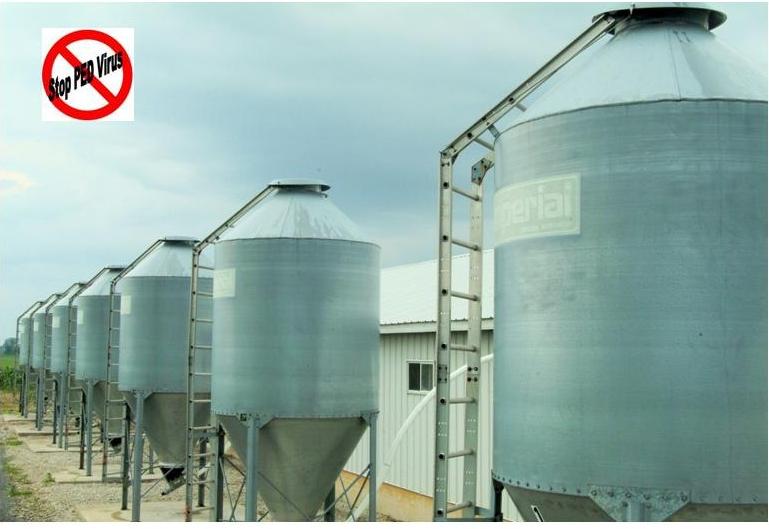3 Hot Headlines: PEDV Can Spread Through Feed, China Imposes Pork Import Restrictions and Antibiotic Wrangling Continues
August 18, 2014

Several pork industry “hot topics” have been making news in recent days. Here are three stories to follow this week. New research validates the concept that porcine epidemic diarrhea virus (PEDV) can be spread via feed. Meanwhile, the pork export market is in flux as countries impose trade restrictions. Antibiotic use is also grabbing headlines as groups seek more comprehensive bans on use in food animals.
PEDV Can Travel Through Feed
Initially, contaminated feed was proposed as a risk factor for spreading porcine epidemic diarrhea virus, however, data were not available to support this theory. Recently published research provides proof of concept of this risk, according to the American Association of Swine Veterinarians (AASV).
Scott Dee, DVM, director of Research for the Pipestone Veterinary Clinic, published research findings in the BMC Veterinary Research Journal. As part of his research, paint rollers were used to collect materials from at-risk feed bins on farms representing three breeding herds clinically affected with PEDV.
According to AASV:
“This material was tested by polymerase chain reaction test (PCR) and determined to be positive for PEDV-RNA (Ct = 19.50-22.20 range). To test infectivity, this material was pooled (Ct = 20.65) and a Treatment group of three-week old PEDV-naive piglets were allowed to consume it via natural feeding behavior. For the purpose of a Positive control, piglets were allowed to ingest feed spiked with stock PEDV (Ct = 18.23) while the negative control group received PEDV-free feed. Clinical signs of PEDV infection (vomiting and diarrhea) and viral shedding were observed in both the Positive control and Treatment group post-consumption with virus and microscopic lesions detected in intestinal samples No evidence of infection was observed in the Negative controls.
These data provide proof of concept that contaminated complete feed can serve as a vehicle for PEDV infection of naive pigs using natural feeding behavior.”
Read more about the research at the AASV website here, or visit the BMC Veterinary Research Journal website here.
China Imposes Pork Import Restrictions
The U.S. Department of Agriculture’s Food Safety and Inspection Service announced last week that China was barring future pork imports from six U.S processing plants and six cold storage facilities over the use of Ractopamine. China requires third-party verification that U.S. pork imports are ractopamine-free.
Reuters News Service reports that the import restrictions may be a trade-blocking move more than an issue of pork quality or safety.
Reuters says:
“How long the Chinese ban of these plants will remain in place is not known.
But in this situation, analysts say, political pressures within China could be at play: The country's domestic pork production was up 3.4% in the first quarter of this year, over the same time a year earlier, according to China's National Bureau of Statistics.
So the export tussle involving Tyson and the others may be partially fueled by China's bid to slow down overseas hog supplies in order to protect domestic prices and production, said John Ginzel, an analyst with Chicago-based brokerage firm Linn Group.”
Perspective is Necessary on Antibiotic Issues
According to Food Safety News, when it comes to fighting antibiotic resistance, Richard Carnevale of the Animal Health Institute (AHI), which represents the veterinary pharmaceutical industry, is asking, “Are we putting more resources into this than need be?”
AHI’s Vice President of Regulatory, Scientific and International Affairs had not intended to offer public comment last week during the National Antimicrobial Resistance Monitoring System (NARMS) Scientific Meeting, but he changed his mind because he felt the need to address criticisms leveled at the Food and Drug Administration’s (FDA) Guidance for Industry No. 213, which aims to ban the use of antibiotics to promote growth in food animals.
Food Safety News reports:
“If we want to phase out growth promotion and move these products to veterinary control, this is how it’s going to happen – with industry’s cooperation,” Carnevale said. “FDA will not be able to do this on their own, regardless of how many regulations or guidelines or legislation.”
Public health advocates have argued that the guidance won’t be effective because antibiotics will be used at the same levels, but under the label of disease prevention rather than growth promotion. Carnevale says that this “simply is not true. If one takes the time to review the currently approved medically important antibiotics that are on the FDA list for GFI #213 action, you will see that the doses are quite different in virtually all cases. There is not the same dose or dose regimen being used for growth promotion and disease prevention.”
Once growth promotion comes off the labels, veterinarians will only be allowed to use those dose levels for prevention, he added. “This process will work and it will be effective,” Carnevale said.
He ended his comments by saying that although he considered all the work presented at the Scientific Meeting “amazing” and that AHI has always supported NARMS, he wondered if the resources being dedicated to antibiotic resistance are out of proportion to the problem.
You May Also Like



